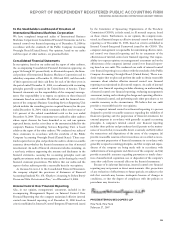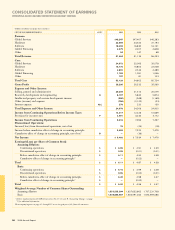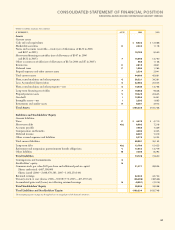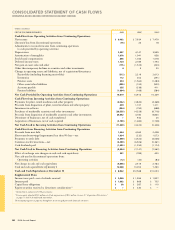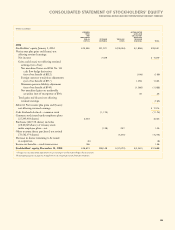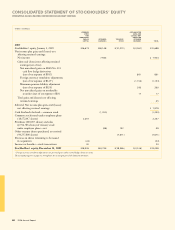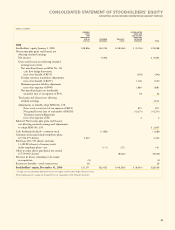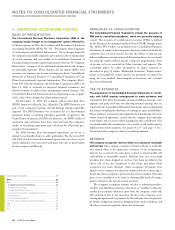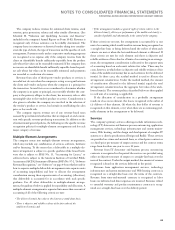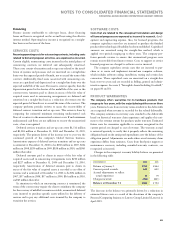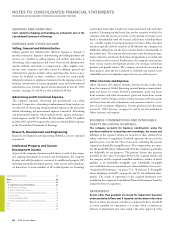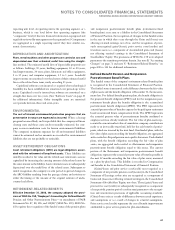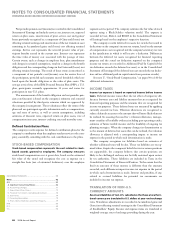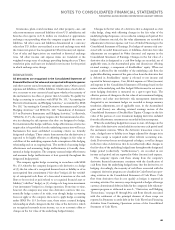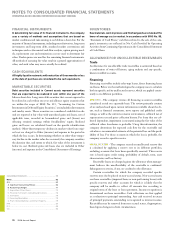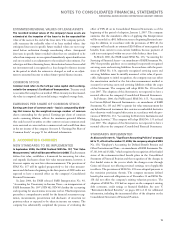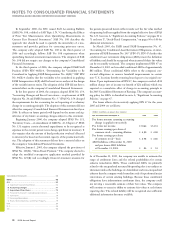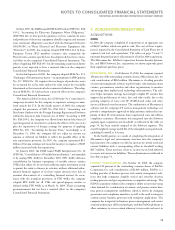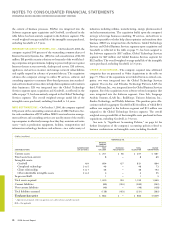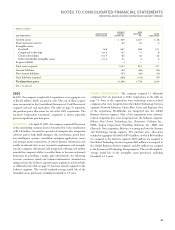IBM 2006 Annual Report Download - page 67
Download and view the complete annual report
Please find page 67 of the 2006 IBM annual report below. You can navigate through the pages in the report by either clicking on the pages listed below, or by using the keyword search tool below to find specific information within the annual report.
Black
MAC
390 CG10
Financing
Finance income attributable to sales-type leases, direct financing
leases and loans is recognized on the accrual basis using the effective
interest method. Operating lease income is recognized on a straight-
line basis over the term of the lease.
SERVICES COSTS
Recurring operating costs for outsourcing contracts, including costs
related to bid and proposal activities, are expensed as incurred.
Certain eligible, nonrecurring costs incurred in the initial phases of
outsourcing contracts are deferred and subsequently amortized.
These costs consist of transition and set up costs related to the instal-
lation of systems and processes and are amortized on a straight-line
basis over the expected period of benefit, not to exceed the term of the
contract. Additionally, fixed assets associated with outsourcing con-
tracts are capitalized and depreciated on a straight-line basis over the
expected useful life of the asset. If an asset is contract specific, then the
depreciation period is the shorter of the useful life of the asset or the
contract term. Amounts paid to clients in excess of the fair value of
acquired assets used in outsourcing arrangements are deferred and
amortized on a straight-line basis as a reduction of revenue over the
expected period of benefit not to exceed the term of the contract. The
company performs periodic reviews to assess the recoverability of
deferred contract transition and set up costs. This review is done by
comparing the estimated minimum remaining undiscounted cash
flows of a contract to the unamortized contract costs. If such minimum
undiscounted cash flows are not sufficient to recover the unamortized
costs, a loss is recognized.
Deferred services transition and set up costs were $1,511 million
and $1,004 million at December 31, 2006 and December 31, 2005,
respectively. The primary driver of the increase year to year was the
continued growth of the company’s Global Services business.
Amortization expense of deferred services transition and set up costs
is estimated at December 31, 2006 to be $386 million in 2007, $324
million in 2008, $250 million in 2009, $188 million in 2010, and $363
million thereafter.
Deferred amounts paid to clients in excess of the fair value of
acquired assets used in outsourcing arrangements were $210 million
and $227 million at December 31, 2006 and December 31, 2005,
respectively. Amortization of deferred amounts paid to clients in
excess of the fair value of acquired assets is recorded as an offset of
revenue and is estimated at December 31, 2006 to be $94 million in
2007, $57 million in 2008, $37 million in 2009, $16 million in 2010,
and $5 million thereafter.
In situations in which an outsourcing contract is terminated, the
terms of the contract may require the client to reimburse the company
for the recovery of unbilled accounts receivable, unamortized deferred
costs incurred to purchase specific assets utilized in the delivery of
services and to pay any additional costs incurred by the company to
transition the services.
SOFTWARE COSTS
Costs that are related to the conceptual formulation and design
of licensed programs are expensed as incurred to research, devel-
opment and engineering expense. Also, for licensed programs, the
company capitalizes costs that are incurred to produce the finished
product after technological feasibility has been established. Capitalized
amounts are amortized using the straight-line method, which is
applied over periods ranging up to three years. The company per-
forms periodic reviews to ensure that unamortized program costs
remain recoverable from future revenue. Costs to support or service
licensed programs are charged to software cost as incurred.
The company capitalizes certain costs that are incurred to pur-
chase or to create and implement internal-use computer software,
which includes software coding, installation, testing and certain data
conversion. These capitalized costs are amortized on a straight-line
basis over two years and are recorded in Selling, general and admin-
istrative expense. See note I, “Intangible Assets Including Goodwill,”
on pages 80 and 81.
PRODUCT WARRANTIES
The company offers warranties for its hardware products that
range up to four years, with the majority being either one or three
years. Estimated costs from warranty terms standard to the deliverable
are recognized when revenue is recorded for the related deliverable.
The company estimates its warranty costs standard to the deliverable
based on historical warranty claim experience and applies this esti-
mate to the revenue stream for products under warranty. Estimated
future costs for warranties applicable to revenue recognized in the
current period are charged to cost of revenue. The warranty accrual
is reviewed quarterly to verify that it properly reflects the remaining
obligation based on the anticipated expenditures over the balance of the
obligation period. Adjustments are made when actual warranty claim
experience differs from estimates. Costs from fixed-price support or
maintenance contracts, including extended-warranty contracts, are
recognized as incurred.
Changes in the company’s warranty liability balance are presented
in the following table:
AT DECEMBER 31: 2006 2005
Balance at January 1 $ $
Current period accruals
Accrual adjustments to reflect
actual experience
Charges incurred () ()
Balance at December 31 $ $
The decrease in the balance was primarily driven by a reduction in
estimated future costs as a result of the divestiture of the company’s
Personal Computing business to Lenovo Group Limited (Lenovo) in
April 2005.
NOTES TO CONSOLIDATED FINANCIAL STATEMENTS
INTERNATIONAL BUSINESS MACHINES CORPORATION AND SUBSIDIARY COMPANIES
65


